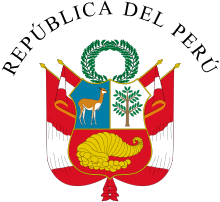Ministry of Economy and Finance (Peru)
The Ministry of Economy and Finance of Peru is the entity in charge of the planning and execution of the economic policies of the Peruvian Government with the goal of optimizing the economic and financial activities of the state, establish macroeconomic activity, and achieve the sustainable growth of the nation's economy. Its headquarters is located in Lima. The current Minister of Economy and Finance is María Antonieta Alva.
| Minister of Economy and Finance
Ministro del Economia y Financia | |
|---|---|
| Style | Minister |
| Reports to | Prime Minister of Peru |
| Residence | Ministry of Economy and Finance |
| Seat | Palacio de Gobierno |
| Appointer | President of Peru Martin Vizcarra |
| Term length | < 10/03/2019-2021 |
| Inaugural holder | José de San Martín (de facto) José de la Riva Agüero (first to bear the title) |
| Formation | February 28, 1823 |
| Succession | General Secretary of Economy and Finance |
| Deputy | Vice Minister of Economy Vice Minister of Housing |
| Website | https://www.mef.gob.pe/es/ |
 |
|---|
| This article is part of a series on the politics and government of Peru |
| Constitution |
|
|
|
|
Autonomies
|
|
|
|
|
|
|
History
On August 13, 1821, José de San Martín, president of Peru, created the General Secretariat of Finance along with the Chancellery, and the War and Navy Department. The first minister of Finance was Hipólito Unanue.
On March 2, 1969 the fundamental law of the Ministry of Finance, Law Decree Nº 17521, which gave the basis for the structure and function of the Ministry of Finance and on June 13, 1969 its name was changed to the current Ministry of Economy and Finance.
By the Law Decree Nº 23123 of July 9, 1980, the name of the ministry was changed again to the Ministry of the Economy Finance and Commerce and it was incorporated into the State Department of Commerce which belonged to the Ministry of Industry, Commerce, Tourism, and Integration. On January 30, 1985 the name was changed back to what it is today.
Functions
The ministries main functions are:
- To plan, direct, and control affairs relating to fiscal policy, finance, debt, budget and treasury.
- To plan, direct, and control the policies of State-run financial agencies as well as harmonize economic activity.
- To plan direct and control affairs related to tariffs.
- Efficiently manage the public resources of the government.
See also
- Council of Ministers of Peru
- Government of Peru
